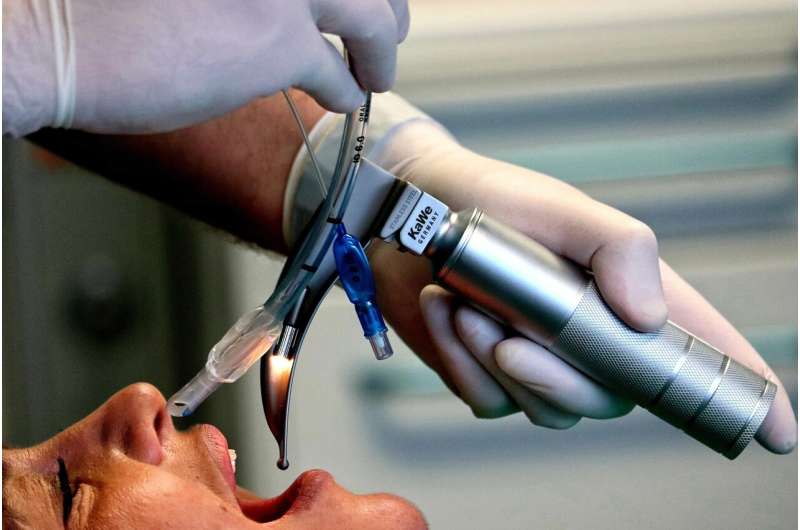This article has been reviewed according to Science X's editorial process and policies. Editors have highlighted the following attributes while ensuring the content's credibility:
fact-checked
peer-reviewed publication
trusted source
proofread
Study shows video laryngoscope increases successful intubation on first attempt

A Vanderbilt University Medical Center-led study comparing the two types of laryngoscopes used in tracheal intubation of critically ill patients showed that the use of a video laryngoscope increased successful intubation on the first attempt, compared to the use of a direct laryngoscope, the standard approach for almost a century.
The DEVICE (DirEct Versus VIdeo LaryngosCopE) trial, published today in the New England Journal of Medicine, compared the two devices used to intubate patients in the emergency department (ED) and the intensive care unit (ICU): a direct laryngoscope and a video laryngoscope.
For almost a century, tracheal intubation has been accomplished with a direct laryngoscope, a simple device composed of a handle and a blade with a light. But over the past 20 years video laryngoscopes have become more widely used. The device has a camera near the tip of the blade to improve viewing the vocal cords. Using a video laryngoscope, a clinician views the placement of the endotracheal tube on a screen.
"More than 1.5 million critically ill adults undergo tracheal intubation outside of an operating room in the U.S. each year, and about 80% of those are with a direct laryngoscope because the video devices are more expensive," said Matthew Semler, MD, MSc, assistant professor of Medicine in the Division of Allergy, Pulmonary and Critical Care Medicine, and co-senior author of the study, along with Jonathan Casey, MD, assistant professor of Medicine.
"Without evidence to tell us whether the video laryngoscope is worth the additional cost, their uptake into practice has been incomplete," he said.
"In the ED and ICU failure to intubate the trachea on the first attempt occurs about 20-30% of the time, leading to an increased risk of life-threatening complications, such as low oxygen levels in the blood, changes in blood pressure, cardiac arrest, even death," Semler said.
"But until now, there hasn't been definitive data to tell us whether a video laryngoscope is better than a direct laryngoscope for intubation of critically ill adults. Although video laryngoscopes are known to improve view, it has been unclear until now if they improve the ease with which a tube is passed. A few small and conflicting studies have been published, and the lack of definitive evidence has slowed adoption."
"Even in places where both devices are available, including at Vanderbilt, many physicians have believed they were equivalent and use of a direct laryngoscope remains common," Semler said.
The study included 1,417 patients from 17 emergency departments and ICUs in 11 hospitals around the country. The primary question asked was whether one device is better for inserting the breathing tube successfully on the first attempt.
"In our randomized trial successful intubation on the first attempt occurred in 71% of patients in the direct laryngoscope group and 85% of patients in the video laryngoscope group, a 14% absolute increase," said Matthew Prekker, MD, MPH, assistant professor of Emergency Medicine and Internal Medicine at Hennepin County Medical Center and first author of the study.
The research group also looked at a secondary outcome—complications.
"There are other complications that occur more commonly when you can't successfully place a breathing tube on the first try, like cardiac arrest," Casey said. "We hope that using a video laryngoscope will prevent these rare but important events, but proving this would require a larger trial."
"What we came away with in this trial is that going forward, the really massive difference in placing a breathing tube on the first attempt is enough to make the video laryngoscope the first-line device for intubating critically ill adults in the ED and ICU."
Semler said the study also shows that the video laryngoscope appears to be especially helpful for the less experienced clinician.
"Some tracheal intubations are done by anesthesiologists who have intubated thousands of patients over their lifetime, but many in the ED and ICU are done by physicians who have less overall experience intubating. The video laryngoscope appears to be especially helpful when the person performing the intubation is less experienced. It basically doubles the chances of putting a breathing tube in successfully on the first try, probably because of the ability to very clearly see the vocal cords."
Semler said that more study is needed to compare the two types of video laryngoscopes—one shaped just like the direct laryngoscope, and the other, hyperangulated with a curved blade.
"Now that we know we should be using the video laryngoscope, the next logical question is which type. We hope that future research can answer that question."
More information: Matthew E. Prekker et al, Video versus Direct Laryngoscopy for Tracheal Intubation of Critically Ill Adults, New England Journal of Medicine (2023). DOI: 10.1056/NEJMoa2301601



















